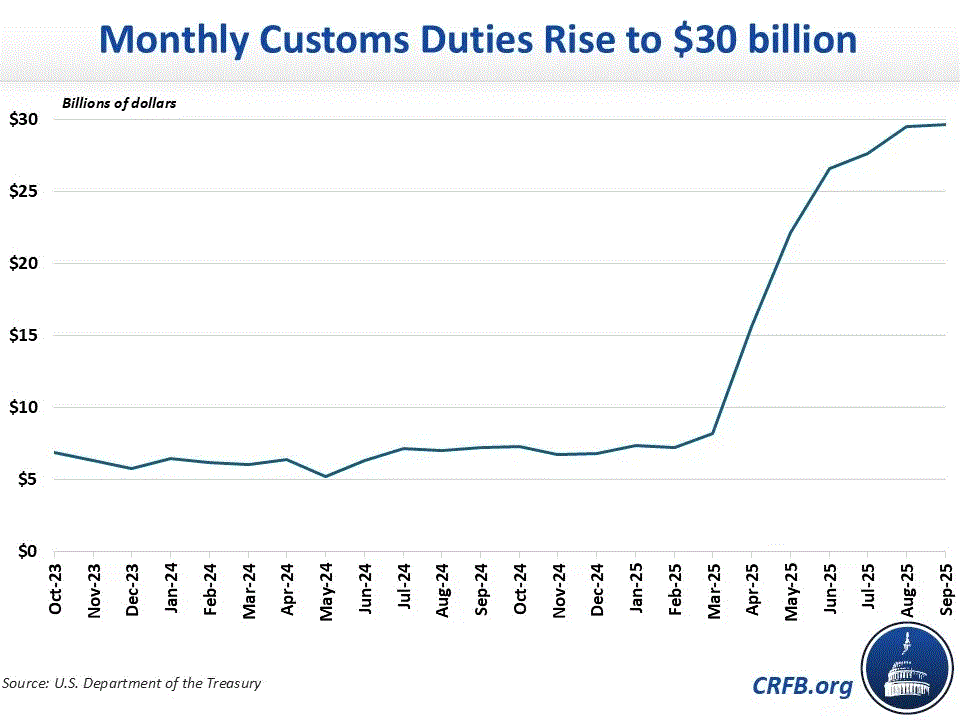
Oct 27, 2025 - Committee for a Responsible Federal Budget
The federal government raised $195 billion in customs duties in Fiscal Year (FY) 2025, more than 250% of what it collected in FY 2024, according to the final Monthly Treasury Statement of FY 2025. These figures confirm that the Trump Administration’s tariff policies have resulted in a significant increase in tariff revenue - though the net fiscal impact is still uncertain, and court rulings could reduce and reverse these gains.
Even after accounting for these tariffs and roughly $200 billion of one-time student loan savings, the budget deficit for FY 2025 still totaled $1.8 trillion (roughly 6% of GDP). Lawmakers will therefore need to identify substantially more deficit reduction to put debt on a sustainable path, as well as protect or replace any lost tariff revenue should the Supreme Court affirm rulings that many of these tariffs are illegal.
Monthly customs duties have risen dramatically since President Trump’s tariffs began taking effect, from $7 billion in January to $30 billion by September. Total tariff collection was $195 billion for FY 2025, $118 billion or 150% higher than duties collected in 2024.
These figures may understate tariff collection in some ways because President Trump’s initial tariff measures were not enacted until one-third of the way into the fiscal year - with significant additions and revisions to policy throughout the year - and may still not have reached full force due to delayed ordering, frontloading, and other factors. The federal government collected $151 billion from customs duties in the second half of FY 2025, a nearly 300% increase over the same period in FY 2024.
Looking forward, we estimate the existing new tariffs enacted under the Trump Administration will raise about $3 trillion through FY 2035, net of offsetting effects on income and payroll taxes but before considering dynamic effects. Under this conventional scoring, the tariffs would counter about two-thirds of the primary deficit impact of the One Big Beautiful Bill Act (OBBBA) over the next 5 years or four-fifths over 10 years, assuming the temporary parts of OBBBA expire as scheduled.
Although tariffs are currently raising substantial revenue, the U.S. Trade Court has ruled the majority of these new tariffs - those enacted under the International Emergency Economic Powers Act (IEEPA) ・illegal. This ruling was upheld by a federal appeals court, but the tariffs will remain in place until a final Supreme Court ruling. The Supreme Court will hold oral arguments in November, possibly leading to a decision before the end of the year. If the ruling is upheld by the Supreme Court, roughly $90 billion of the $195 billion in tariffs collected so far might need to be refunded according to data from U.S. Customs and Border Protection, and expected future monthly revenue collection could fall by more than half. 1
Looking forward, if the Supreme Court upholds the lower court decisions, projected net new revenue from tariff policies implemented this year will fall by about $2.2 trillion to around $900 billion for the FY 2025 to 2035 period under conventional scoring. Projected tariff revenue itself would decline by $3.0 trillion, partially offset by higher income and payroll tax revenue.
As a result, we estimate annual deficits would total 6.7% of GDP over the next decade - compared to 6.1% under the CRFB Adjusted August 2025 Baseline. And the national debt would rise to 126% of GDP by 2035 as opposed to 120% under the CRFB Adjusted August 2025 Baseline.
Policymakers should therefore be prepared to offset IEEPA tariffs if they are struck down by the Supreme Court. This could include codifying some of the tariffs into law or replacing them with more pro-growth alternatives such as a border-adjusted cash flow tax or spending reductions. In a recent analysis, we laid out five possible ways to replace lost tariff revenue.